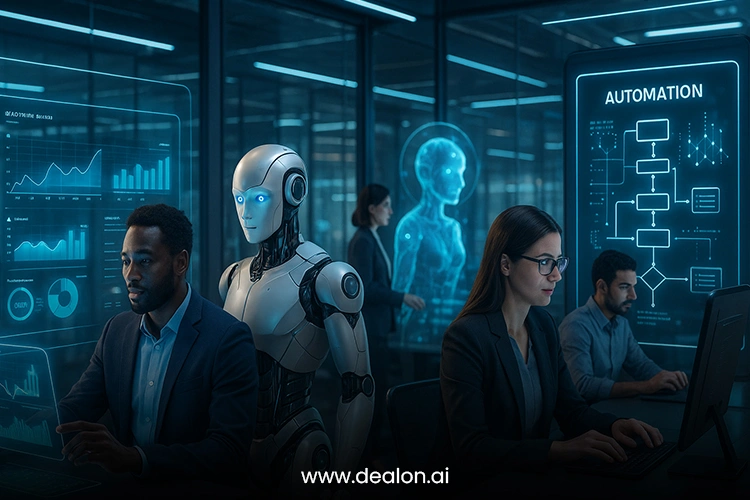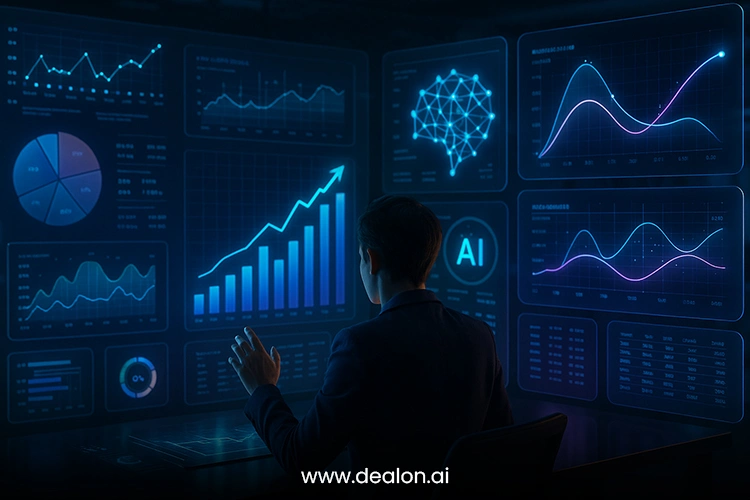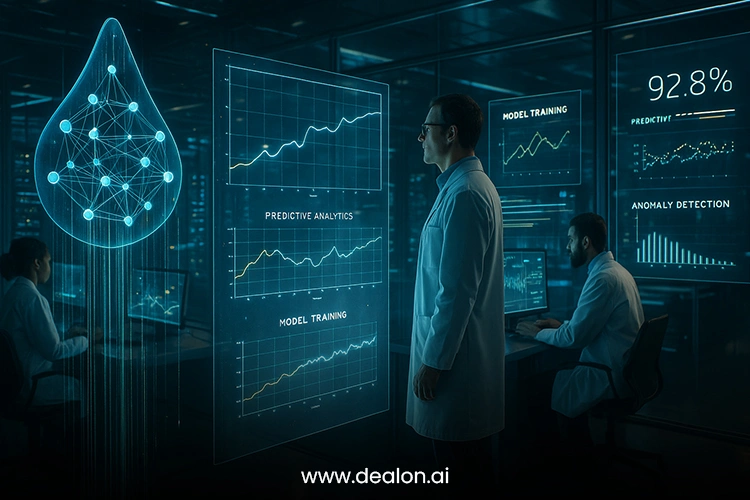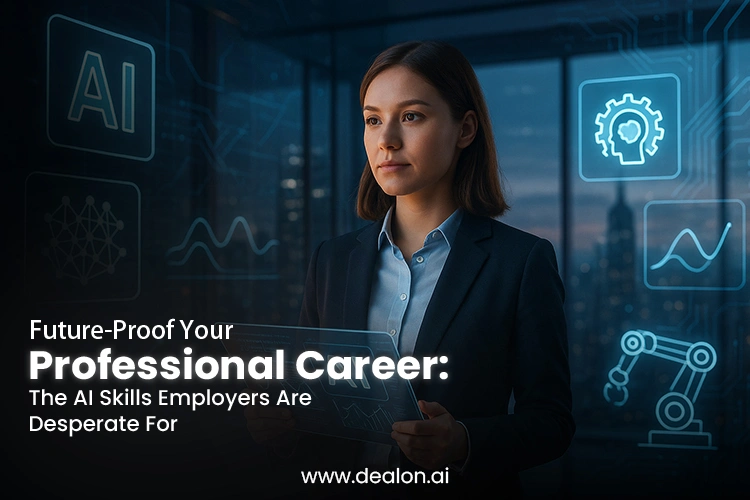Job markets today are ever evolving, while Artificial Intelligence technology has become an everyday part of business transformation. With the increasing importance of AI in business operations, there is a growing need for its specialists. It has become one of the foremost sought-after competencies. From data science, machine learning, automation, etc., barriers are disappearing, and swift adaptation is needed.
Professions today are not being ‘future-proofed’ without proper AI training, and an understanding of technology application is crucial. Integration of AI into the technologies of the likes of Industrie 4.0, Banking and Payment processes, or healthcare requires a proactive and innovative approach. Furthermore, there is a need for effective policies to manage and apply structures in an intuitive, productive, and helpful manner. AI’s data literacy, machine learning, and automation need ethical frameworks to guide their application. The need to innovate and develop a skill set that remains agile is ever constant.
This blog will look at the most-requested AI skills, their importance to a career, and the most worthwhile means to acquire them to be a step ahead in this grim competition in the job market. These skills will greatly amplify a professional’s career, but will also allow them to integrate into the future world, which Artificial Intelligence drives. This world offers a plethora of opportunities and is digital in nature. One needs to adopt AI as the building block of a career to ensure a proper future, and not only to be prepared, but also to be a shaper of it.
Also Read: The Rise of Autonomous AI: Are We Ready to Hand Over Decision Control?
Understanding the AI Revolution in the Workplace

The commencement of AI is not a craze; a business will be the first to be able to use its functionality with its workers and adjust the focus of the employees. AI will allow for many industries to automate and improve routine decision processes. These industries include healthcare, finance, logistics, retail, and more. These organizations will use AI tools and demand employees who can use them globally. This will change the structure of job roles and develop new ones that allow for AI in the workflow.
Data-driven decision-making is, without a doubt, one of the most profound impacts AI has made on the world of work. AI is capable of capturing trends and patterns in a lot of data in a way that is not intuitive to human beings. Thus, businesses are pivoting from decision-making based on guesswork and intuition to solid data analysis decision-making. For example, in the finance sector, AI is used for fraud detection, risk management, and algorithmic trading. In contrast, in the healthcare sector, AI improves patient management, assists in drug discovery, and boosts diagnostic accuracy. In the same manner, AI improves inventory control, targeted marketing, service delivery using chatbots, and customer care.
AI is increasingly becoming a part of the business landscape. It is important to note that employees must understand how to cooperate with AI systems and not view them as competitors. Employees who can use AI tools, understand them, and work with them are going to be in a lot of demand. AI is being accepted as part of a business strategy, which shows how intersectional professionals are becoming more critical.
More and more professionals are needed who can understand the organization and the artificial intelligence technology and unite them. That is why professionals must acquire data literacy, as this will help them apply AI to the organization, as well as be able to make use of actionable data to enhance the business and take it to the next level.
Data Literacy: Transforming and Igniting Strategic Insights from Data

Data is the most critical asset a company can have in this age of AI. In acquiring AI, data is invaluable. It is essential to mention that data is only as important as the organization can make it. Professionals in the era of workplace AI need to be highly data literate. Those who consider themselves experts in data literacy are highly sought after in the workplace because they can optimize data to elevate business performance. Data literacy means being able to comprehend the intricacies of datasets.
This comprehension has to do with the application of the tools Python, R, SQL, and even advanced Excel. Such tools facilitate the manipulation of data to be visualized and presented in ways so that decision makers can easily understand and utilize the data. With the aid of these tools, decision makers can discern patterns and trends, along with extracting practical conclusions from the data provided.
Decision makers use advanced data manipulation programming languages such as Python and R, while also utilizing SQL to formulate and retrieve data within data systems. As a data proficient business person, you should be able to maneuver these tools as they are the standard within the framework of business.
Data literacy also extends to the comprehension of several tools used to analyze data, as well as predictive modeling. These professionals are equipped with predictive modeling tools, enabling them to forecast based on data for business strategies. Predictive modeling, for instance, allows a company to estimate customer demand and stock the needed inventory so that stockouts or overstocking can be avoided. The opposite of predictive modeling is statistical analysis. This is used to find correlations as well as cause-and-effect relationships in data to improve data-driven marketing strategies and refine operational efficiencies.
Putting data into a visual medium is also fundamental to data literacy. The data is only as good as how well it is presented, as the saying goes. Data visualisation tools like Tableau, Power BI, or Google Data Studio can assist users in presenting data in a sophisticated manner. Decision-makers can use graphs, charts, complex datasets, spider plots, and heat maps to provide quick and accurate insight to help them make data-based decisions. When it comes to sales performance or the subtle art of behavioral analysis, skilled data visualizers are invaluable in assisting decision-makers to interpret data and make use of it accordingly.
An equally important part of data literacy is the most complex AI data skills, which include being able to tell a coherent story representing the most complicated AI data services seamlessly. There is a paradox of value. AI systems’ translations of data into actionable insights receive less value than the cost and time saved in systemized strategic military business planning. The gap between AI analysis and business plans needs a translator, as there will be more AI systems in the future that will be misunderstood and can be used to make better decisions.
Data literacy is vital when it comes to advancing a person’s career in the AI-enhancing industry. With the incorporation of AI in the business world, the professional world is expected to understand the importance of leveraging, interpreting, and analyzing data. These professionals will be able to turn raw data into strategic data to improve productivity, innovation, and decision-making.
Machine Learning and Predictive Analytics

Machine learning is definitely a word that gets thrown around quite often. Still, in reality, it is at the forefront of a large bulk of the advancements we have been seeing in artificial intelligence. By definition, this is a branch of AI that provides the ability for the system to improve and grow through experience and the inclusion of new data over a timespan.
With the new opportunities that open up for companies in relation to customer engagement and operational efficiency, the use of machine learning is expanding widely across various industries. Because of this, the demand for professionals to actively implement, design, and evaluate machine learning systems is on the rise, along with the demand for professionals who possess the capability to use ML most effectively within the job marketplace.
Predictive analytics models help people and companies to understand changes, understand operational risk, and use value addition more resourcefully. These predictive models help in knowing consumer behavior, knowing how the business market operates, and knowing the potential challenges a business may have. Predictive analytics in finance is similar to a crystal ball in the stock market, as it gives priceless insight for risk managers, stakeholders, and even investment portfolios.
Apart from the common types of ML, which are supervised and unsupervised, other machine learning models, like NLP, and more sophisticated types of machine learning, are increasingly used and recognized. The more complex models, like neural networks, help to solve complex problems such as decision making, image and voice recognition, etc. NLP helps to understand the human language and spoken words, which is very helpful in customer service, content generation, and even analyzing sentiments.
AI Automation and Optimization of Workflows
AI automation and optimization of workflows are a vital part of the current industrial revolution. They are profoundly changing the patterns of work and the definitions of jobs in various businesses. It is also changing perceptions about work with machines in a collaborative manner. As outlined in the United Nations Development Programme, automation systems should not be understood in terms of substitution.
Automation systems strive to enhance the capacity of a human agent. This is done by taking away mindless and dull work from the daily work schedule. Doing so, they would be free from the daily grind to attend to work that calls for innovation, strategic thinking, and high-level brain engagement.
This ideal setting is easily achievable with the assistance and support of machines. All of the robotic systems work in a coordinated manner to achieve that very goal. This is the ideal use of collaborative machines, where the professionals gain the most. It increases the amount of work done, decreases the amount of energy spent, and optimizes professional engagement. All of the robotic systems work in a coordinated manner to achieve that very goal. This ideal setting is easily achievable with the assistance and support of machines.
All in all, this is the ideal use of collaborative machines where the professionals gain the most. This is the perfect scenario where there is a quantum leap in work patterns, work usage, and work engagement. AI does most of the suggested work. For most professionals, this is a fantastic opportunity. It presents an opportunity to learn, gain, and cultivate various systems and approaches to automate work.
Robotic process automation, or RPA, is one of the most widely used automation technologies in the world. RPA can do repetitive tasks such as data entry, processing invoices, managing payroll, or even routing customer support tickets. Automating workflows with RPA technology can lead to increased efficiency, reduced manual mistakes, and greater uniformity in operations. The full potential of RPA can only be utilized when RPA technology is incorporated within the greater workflow of an organization.
This is where RPA specialists and systems designers who specialize in AI process automation and workflow optimization come in. Their job is to design the most efficient systems where AI tools can be integrated with workflows, in addition to aligning the automation with the company’s overall strategic goals.
To eliminate potential bottlenecks to AI-driven automation, the processes must be adequately assessed, differentiated, and value-added to. This step means a lower threshold in setting boundaries, which dictates a more straightforward solution to be evaluated, answering various questions, and setting criteria. For example, which tasks can be placed in a funnel without the threat of diminished customer support and satisfaction or loss in compliance? It is a fundamental requirement of every AI tool to adhere to the organizational ethical system, comply with local and international regulations, and data protection laws to provide value to the audience and customers.
Workflow automation also offers many benefits, including enhanced data accuracy, improved operational cost accuracy, and other operational efficiencies. Since AI takes over repetitive processes, human employees now engage in more high-level activities such as customer engagement and problem-solving. Also, more and more businesses can now scale operations while foregoing the proportional increase in firms’ workforces, thereby increasing profitability and operational flexibility.
Ethical AI and Responsible Innovation
Like any new cutting-edge technology, the growth of AI comes with specific ethical questions. Schools don’t offer training for the type of challenges AI poses, with the technology still being in its early stages of real-world application. AI is involved in central decision-making processes in recruitment, healthcare, law, and banking. Without appropriate governance and regulatory frameworks, AI systems might be applied in unfair, biased, and non-transparent decision-making systems. To meet the gap between technological and social advancements, companies have started employing AI ethicists.
Biased AI systems and the absence of any fairness consideration systems are more likely to perpetuate and aggravate systemic biases. Bias detection and mitigation professionals can help eliminate systems that discriminate based on race, gender, or other demographic factors. Such experts can audit AI systems, perform bipartisan detection across the development cycle, and implement bias countermeasures to ensure equitable AI systems.
In another critical area of ethical AI, the preservation of privacy is another ethical AI concentration. While AI technologies gather and analyze a record amount of personal data, the paramount privacy concern is a significant issue. There are many AI systems, and all of them are expected to comply with data protection laws. These data protection laws are about privacy-preserving AI techniques, other differential privacy, or federated learning systems with AI.
AI’s ability to surveil and manipulate personal systems has raised concerns over its ability to infringe on civil liberties and human rights. For that reason, we cannot ensure that AI systems are free of responsibility. Those who understand the concept can help organizations develop the appropriate auditing frameworks.
These frameworks help to maintain the systems in crystal-clear terms and assign proper actions to the AI’s behavior. This might include the use of Explainable AI (XAI). With AI, XAI moves a step closer to human users by providing tools that aid in understanding the decision-making process of AI. This, in turn, offers better supervision by XAI on decision-making processes. This is crucial in areas where verticals like healthcare and criminal justice are reliant on AI systems to make decisions that affect people’s lives.
These principles in this context of ethical AI will not only help professionally, but they will also make such individuals instrumental in the responsible, transparent, and trustworthy use of AI. Therefore, the ever-growing use of AI means that the people who can offer a balance between ethical and innovative approaches will help in the responsible use of AI. This will ensure that the moral nature of using AI is not compromised.
Continuous Learning: Remain Ahead in the Evolving Landscape
According to the world of AI, which has rapid growth, professionals are required to participate and practice Learning for Life methodologies to be able to cope with the advancements. AI has come to the point where new technologies, methods, and techniques are developed daily. It is guaranteed that the newest of techniques deemed cutting-edge today might be out of style by tomorrow. This serves as a reason why continuous growth and development are needed for professionals in this space. For people who are trying to secure a career in AI, learning to be inquisitive and open-minded is a stepping stone to harnessing the upper echelons of AI that are to come.
Using online websites to take courses, certifications, or attend relevant workshops is a surefire way to be at the forefront of AI. The websites Coursera, Udacity, and edX, for example, offer online programs in different fields of AI, which are often developed with the help of significant educational and tech firms. These websites’ professionals can work; there is no shortage of programs, as the learning is self-paced. Furthermore, the certificates that are provided can improve the credibility of a professional as they serve as an affirmation that the individual has completed the courses and has gained the relevant experience and know-how.
Participating in open-source projects and engaging in AI communities is also a great way to further one’s learning. For instance, GitHub allows practitioners to work with others to solve real-life problems and hone their skills. Also, members of open-source AI projects get to know industry trends, collaborate with professionals, and expand their network in the AI sector. Such work promotes boundary-pushing because professionals incorporate new and innovative ideas on what is possible in AI.
Working in AI communities, from the internet and in-person, is yet another way to gain knowledge on the most recent trends in the industry. For example, attending AI conferences, webinars, and workshops allows one to listen to experts, learn about new ideas, and interact with other attendees. In these scenarios, attendees can use the AI network to gain access to job offers and promotions at different organizations to help build their AI careers. Additionally, materials, including research papers and tutorials, are a great way to help practitioners learn and understand the problems with best AI practices.
Conclusion
To sum up, knowing how to work with AI, whether it’s using machine learning, understanding data, or working with AI ethics, is crucial to career retention in a world driven by artificial intelligence. Predictive modeling, automated AI workflows, and AI technology ethics experts will be highly sought after as they guide businesses in socially responsible innovations.
Certifications, open-source work, and tinkering in the field are all good ways to practice continuous learning. Professionals need to commit to a new knowing, or as some say, “set it and forget it,” culture to remain flexible and in demand. That way, they can lead the AI sectors of the future, all while taking into account the ethics, impacts, and implications of the technology.

